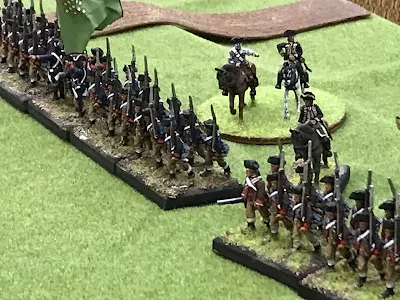The Battle of Hanging Rock was a confused affair that has been made more difficult to follow because of poor secondary sources and the repetition of them.
Before posting my table top refight here are a few notes to explain where I am coming from. Please note the historical marker signs also got a lot wrong! No 63rd or 71st at the battle. It was American Loyalist vs American Patiot. A newer sign has since replaced this one.
First off the name. The Battle site is named after the curious rock formations in the area. Today there is a pleasant walking path through the park.
British at Hanging Rock
Lieutenant-Colonel Francis Rawdon in a Letter to Colonel McMahon, January 19, 1801 that Hanging Rock was defended by "400 provincials and 800 militia." Who were they?
Regular loyalist regiments: there were soldiers from three different Provincial or Loyalist regiments: The British Legion infantry, The Prince of Wales’ American Regiment, and the Royal North Carolina Regiment.There total losses were 38 men killed, 69 wounded, 71 missing.
In regards to the number of missing, 43 men were captured by the Americans. Half of these men were privates and noncommissioned officers of the Prince of Wales’ American Regiment that surrendered to the Americans during the fighting. The other half had been both wounded and captured (most, if not all of these, were also of the Prince of Wales’ American Regiment).
Some secondary accounts claim that the King’s Rangers, commanded by Colonel Thomas Brown, were at the battle. This stems from a misreading of Tarleton’s description of the battle, which refers to Brown’s regiment, but means Colonel Montfort Browne, commander of the Prince of Wales’ American Regiment. Browne was not present on this occasion, and command of the Prince of Wales’ American Regiment was left to Major John Carden. Because of absences in the field officers for the other regiments, Carden also commanded the entire post.
Reinforcement: A detachment of 40 mounted infantry from the British Legion arrived during the battle. I suggest rolling two d6 for when they arrive.
American Strength and Losses at Hanging Rock
Thomas Sumter claimed that he had “Six hundred brave men,” and other participant statements point to a similar total. He divided his force into three parts, and each contained around 200 men. These divisions are henceforth referred to as the left, center, and right divisions, after their relative positions at the beginning of the battle. Possibly the left division was commanded by William Hill, the center by Robert Irwin, and the right by William Davie.
Left Division: South Carolina militia regiments, including William Bratton’s regiment, Andrew Neal’s regiment, Edward Lacey’s regiment, and Joseph Brandon’s regiment. Most of the men in these regiments had seen action before, including at Williamson’s Plantation and Rocky Mount.
Center Division: A battalion of 200 North Carolina militiamen under the command of Robert Irwin. These men hailed from Mecklenburg Countries. A small group if Catawa Indians fought with them.
Right Division: Major William Davie’s troop of dragoons (70-80 men), supported by a mixture of North and South Carolina militia units. Again most of these men had also seen battle before.
American Losses:
Thomas Sumter claimed that he lost 20 killed, 40 wounded, and 10 missing. Other American participants gave lower figures, but their claims are less reliable. The 10 missing men were likely killed or wounded, but as the fighting took place over a wide area, they were not found by their comrades before the end of the battle. The British estimated American losses at about 100 men.
Notes:
Wikipedia reference:
https://en.m.wikipedia.org/wiki/Battle_of_Hanging_Rock
Todd Braisted (2001). A History of the Prince Of Wales' American Regiment
The Revolutionary War Sketches of William R. Davie
(Davie's account also appears in, John H. Wheeler (1851). Historical Sketches of North Carolina from 1584 to 1851, Vol. 1.)
Banastre Tarleton. (1787). A History of the Campaigns of 1780 and 1781.
Charles Stedman. (1794). The History of the Origin, Progress, and Termination of the American War, Vol. 2.

























